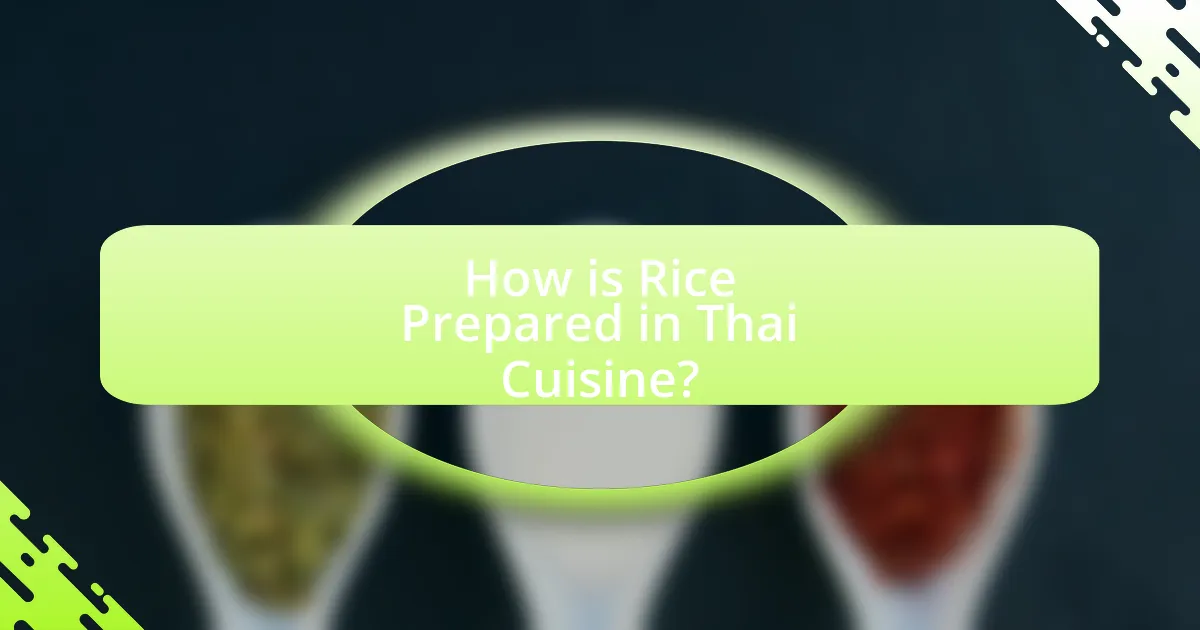Rice is a fundamental staple in Thai meals, serving as the primary source of carbohydrates and playing a significant role in the country’s cultural practices and traditions. The article explores the various types of rice used in Thai cuisine, such as jasmine and sticky rice, and their preparation methods, highlighting how rice complements a wide range of dishes, including curries and stir-fries. Additionally, it discusses the nutritional benefits of rice, its impact on traditional eating habits, and the potential drawbacks of excessive consumption, while also offering alternatives for those looking to reduce rice intake. Overall, the article emphasizes rice’s integral role in Thai meals and its importance in the dietary framework of Thailand.

Why is Rice Considered a Staple in Thai Meals?
Rice is considered a staple in Thai meals due to its central role in the diet and cultural practices of Thailand. It serves as the primary source of carbohydrates, providing essential energy for daily activities. In Thailand, rice is not only a food item but also a symbol of life and prosperity, deeply embedded in social and religious customs. The country produces a variety of rice, with jasmine rice being particularly popular for its fragrance and texture, which complements a wide range of Thai dishes. Historical data indicates that rice cultivation in Thailand dates back thousands of years, establishing its significance in Thai agriculture and cuisine.
What role does rice play in Thai culture and cuisine?
Rice is a fundamental staple in Thai culture and cuisine, serving as the primary source of carbohydrates in most meals. In Thailand, rice is not only a dietary staple but also a symbol of life and prosperity, deeply embedded in cultural practices and traditions. For instance, jasmine rice, known for its fragrant aroma, is often served with various dishes, highlighting its significance in daily dining. Additionally, rice is featured in numerous rituals and festivals, such as the annual rice planting ceremony, which celebrates the agricultural cycle and the importance of rice cultivation to the Thai economy and identity.
How has rice shaped traditional Thai eating habits?
Rice has fundamentally shaped traditional Thai eating habits by serving as the staple food and central component of most meals. In Thai culture, rice is not merely a side dish but is often the primary element around which various dishes are organized, reflecting its significance in daily life and social gatherings. The prevalence of jasmine rice, known for its fragrant aroma and texture, exemplifies how rice varieties influence culinary practices and preferences. Additionally, rice consumption patterns, such as eating rice with a variety of curries and vegetables, highlight its role in promoting balance and harmony in meals, which is a core principle of Thai cuisine. Historical evidence shows that rice cultivation has been integral to Thai agriculture for centuries, reinforcing its status as a cultural and nutritional cornerstone in Thailand.
What cultural significance does rice hold in Thai society?
Rice holds immense cultural significance in Thai society as it is considered a staple food and a symbol of life and prosperity. In Thailand, rice is not only a primary source of nourishment but also plays a central role in various cultural rituals and traditions, such as weddings and religious ceremonies. The Thai phrase “khao” means both rice and food, highlighting its integral role in daily life. Historically, rice cultivation has shaped Thai agriculture and economy, with the country being one of the world’s largest rice exporters. This deep-rooted connection to rice reflects the Thai people’s respect for agriculture and their reliance on rice for sustenance and cultural identity.
How does rice complement other dishes in Thai meals?
Rice serves as a fundamental component in Thai meals, acting as a neutral base that balances the bold flavors of accompanying dishes. It absorbs sauces and spices, enhancing the overall dining experience by providing texture and a contrasting element to spicy, sour, or savory dishes. For instance, jasmine rice, commonly used in Thailand, has a fragrant quality that complements curries and stir-fries, allowing the rich flavors to shine while also offering a satisfying mouthfeel. This synergy between rice and other dishes is essential in Thai cuisine, where meals are often designed to be enjoyed together, creating a harmonious blend of tastes and textures.
What types of dishes are typically served with rice?
Dishes typically served with rice include curries, stir-fries, and grilled meats. In Thai cuisine, for example, green curry, pad Thai, and grilled chicken are commonly paired with rice, as rice serves as a staple that complements the flavors and textures of these dishes. The combination of rice with these dishes is rooted in cultural practices, where rice acts as a neutral base that balances the spiciness and richness of the accompanying flavors.
How does rice enhance the flavors of Thai cuisine?
Rice enhances the flavors of Thai cuisine by serving as a neutral base that balances the bold and complex flavors of various dishes. In Thai meals, rice absorbs the spices, herbs, and sauces, allowing the intricate flavors of ingredients like lemongrass, chili, and fish sauce to shine through. Additionally, the texture of rice complements the crunchiness of vegetables and the tenderness of proteins, creating a harmonious dining experience. This synergy is evident in traditional dishes such as Pad Thai and Green Curry, where rice acts as a vehicle for the rich flavors, making each bite more satisfying.
What are the different varieties of rice used in Thai cooking?
The different varieties of rice used in Thai cooking include Jasmine rice, Sticky rice, and Thai brown rice. Jasmine rice, known for its fragrant aroma and fluffy texture, is the most commonly used rice in Thai cuisine, often served with curries and stir-fries. Sticky rice, also called glutinous rice, is essential in northern and northeastern Thai dishes, typically served with grilled meats and used in desserts. Thai brown rice, a whole grain option, is gaining popularity for its nutritional benefits and is used in various dishes as a healthier alternative. These rice varieties are integral to Thai meals, reflecting the country’s culinary traditions and regional preferences.
What are the characteristics of Jasmine rice?
Jasmine rice is characterized by its long grain, fragrant aroma, and slightly sticky texture when cooked. This variety of rice, primarily grown in Thailand, has a unique nutty flavor that enhances the taste of various dishes. Jasmine rice typically has a high amylose content, which contributes to its fluffy texture and allows it to absorb flavors well during cooking. The grains are often pearly white, and when cooked, they become soft and moist, making them an ideal accompaniment to Thai meals, where they complement spicy and savory flavors.
How does sticky rice differ from other types of rice?
Sticky rice differs from other types of rice primarily in its high amylopectin content and low amylose content, which results in a glutinous texture when cooked. This unique composition allows sticky rice to clump together, making it ideal for eating with hands or using as a base for various Thai dishes. In contrast, other rice varieties, such as jasmine or basmati, have higher amylose levels, leading to a fluffier and more separate grain when cooked. The distinct characteristics of sticky rice are essential in Thai cuisine, where it is often served alongside savory dishes or used in desserts, highlighting its cultural significance.

How is Rice Prepared in Thai Cuisine?
Rice in Thai cuisine is primarily prepared by steaming or boiling, often using jasmine rice, which is favored for its fragrant aroma and fluffy texture. The process typically involves rinsing the rice to remove excess starch, followed by soaking it for about 30 minutes to enhance the cooking process. After soaking, the rice is cooked in a rice cooker or on the stovetop with a specific water-to-rice ratio, usually 1:1.5, ensuring the rice absorbs the right amount of moisture. This method results in perfectly cooked rice that serves as a staple accompaniment to various Thai dishes, reflecting its cultural significance in meals.
What are the common cooking methods for rice in Thailand?
The common cooking methods for rice in Thailand include steaming, boiling, and frying. Steaming is the traditional method, often used for sticky rice, which is a staple in many Thai dishes. Boiling is frequently employed for jasmine rice, which is a popular variety in Thai cuisine, ensuring it is fluffy and aromatic. Frying, particularly in the form of fried rice, is a common preparation that incorporates various ingredients and flavors, making it a versatile dish. These methods reflect the cultural significance of rice in Thai meals, where it serves as a fundamental component of the diet.
How is steamed rice prepared and served?
Steamed rice is prepared by rinsing uncooked rice to remove excess starch, then cooking it in a rice cooker or pot with a specific water-to-rice ratio, typically 1:1.5 for white rice, and allowing it to steam until tender. Once cooked, steamed rice is served as a staple side dish in Thai meals, often accompanied by various curries, stir-fries, or grilled meats, enhancing the overall flavor and texture of the meal. This method of preparation ensures that the rice remains fluffy and separate, which is essential in Thai cuisine, where rice acts as a base for absorbing sauces and flavors from other dishes.
What techniques are used for cooking sticky rice?
The primary techniques used for cooking sticky rice include soaking, steaming, and using a bamboo basket. Soaking the rice for several hours, typically overnight, allows the grains to absorb water, which is essential for achieving the desired texture. After soaking, the rice is drained and placed in a bamboo steamer lined with cheesecloth or banana leaves, which allows steam to circulate while preventing the rice from falling through. Steaming the rice for about 20 to 30 minutes ensures it becomes tender and sticky. This method is traditional in many Southeast Asian cultures, particularly in Thailand, where sticky rice is a staple in meals.
What are the traditional accompaniments for rice in Thai meals?
Traditional accompaniments for rice in Thai meals include a variety of dishes such as curries, stir-fries, and salads. These accompaniments enhance the flavor and texture of the rice, making it a central part of the meal. Common examples are green curry, red curry, pad Thai, and som tam (papaya salad). The combination of these dishes with rice reflects the balance of flavors in Thai cuisine, which emphasizes sweet, sour, salty, and spicy elements.
Which sauces and condiments are commonly paired with rice?
Common sauces and condiments paired with rice include soy sauce, fish sauce, chili sauce, and curry sauce. Soy sauce is widely used in various Asian cuisines, enhancing the umami flavor of rice dishes. Fish sauce, a staple in Thai cooking, adds a salty and savory depth to rice, often found in dishes like fried rice. Chili sauce provides heat and flavor, complementing rice in spicy dishes. Curry sauce, prevalent in Thai cuisine, is often served with rice to create a rich and aromatic meal. These condiments are integral to enhancing the taste and experience of rice in Thai meals.
How do vegetables and proteins complement rice dishes?
Vegetables and proteins enhance rice dishes by providing essential nutrients and flavors that create a balanced meal. Vegetables contribute vitamins, minerals, and fiber, which improve digestion and overall health, while proteins offer amino acids necessary for muscle repair and growth. For instance, a dish like Thai fried rice often includes vegetables such as peas and carrots, which add color and texture, alongside proteins like chicken or tofu, which increase satiety and nutritional value. This combination not only makes the dish more satisfying but also aligns with dietary guidelines that recommend a variety of food groups for optimal health.

What Nutritional Benefits Does Rice Provide in Thai Meals?
Rice provides essential carbohydrates, making it a primary energy source in Thai meals. It is low in fat and contains no cholesterol, contributing to heart health. Additionally, rice is a good source of B vitamins, particularly thiamine and niacin, which are important for energy metabolism and maintaining healthy skin and nerves. Furthermore, rice contains minerals such as magnesium and phosphorus, which support bone health and metabolic functions. The fiber content in whole grain rice varieties aids in digestion and helps maintain stable blood sugar levels. These nutritional benefits underscore rice’s vital role in the dietary framework of Thai cuisine.
How does rice contribute to a balanced diet in Thailand?
Rice serves as a staple food in Thailand, providing essential carbohydrates that fuel energy needs. It is a primary source of calories for the Thai population, with approximately 80% of daily caloric intake derived from rice. Additionally, rice is low in fat and contains some protein, contributing to a balanced diet when paired with vegetables, proteins, and fats found in traditional Thai dishes. The inclusion of rice in meals supports dietary diversity, as it complements various ingredients, enhancing nutritional value.
What essential nutrients are found in different types of rice?
Different types of rice contain essential nutrients such as carbohydrates, proteins, vitamins, and minerals. For example, white rice primarily provides carbohydrates and small amounts of protein, while brown rice is richer in fiber, magnesium, and B vitamins due to its bran and germ layers being intact. Jasmine rice, commonly used in Thai cuisine, offers a fragrant aroma and contains carbohydrates along with some protein and essential amino acids. Additionally, black rice is noted for its high antioxidant content, particularly anthocyanins, which contribute to its health benefits. These nutrient profiles highlight the importance of rice varieties in providing energy and essential nutrients in Thai meals.
How does rice consumption affect energy levels and health?
Rice consumption significantly affects energy levels and health by providing a primary source of carbohydrates, which are essential for energy production in the body. Carbohydrates from rice are quickly converted into glucose, the main energy source for cells, thereby enhancing physical performance and cognitive function. Studies indicate that diets rich in whole grains, including brown rice, are associated with lower risks of chronic diseases such as heart disease and type 2 diabetes, due to their high fiber content and beneficial nutrients. For instance, a study published in the American Journal of Clinical Nutrition found that whole grain consumption is linked to improved metabolic health and reduced inflammation. Thus, rice, particularly in its whole grain form, plays a crucial role in maintaining energy levels and promoting overall health.
What are the potential drawbacks of rice consumption?
Rice consumption can lead to several potential drawbacks, including high carbohydrate intake, which may contribute to weight gain and obesity. Studies indicate that diets high in refined carbohydrates, such as white rice, can increase the risk of metabolic syndrome and type 2 diabetes. Additionally, rice can contain arsenic, particularly in certain varieties, which poses health risks when consumed in large amounts over time. Research published in the journal Environmental Health Perspectives highlights that long-term exposure to arsenic through rice consumption can lead to adverse health effects, including cancer and cardiovascular diseases. Furthermore, excessive rice consumption may lead to nutrient deficiencies, as rice is low in essential vitamins and minerals compared to other whole grains.
How can excessive rice intake impact health?
Excessive rice intake can lead to health issues such as obesity, diabetes, and cardiovascular diseases. Consuming large quantities of rice, particularly white rice, increases carbohydrate intake, which can elevate blood sugar levels and contribute to insulin resistance. A study published in the American Journal of Clinical Nutrition found that high consumption of white rice is associated with a higher risk of type 2 diabetes, particularly in Asian populations where rice is a staple food. Additionally, the lack of fiber in white rice compared to whole grains can lead to digestive problems and increased hunger, promoting overeating.
What alternatives exist for those looking to reduce rice consumption?
Quinoa serves as a nutritious alternative for those looking to reduce rice consumption. Quinoa is a complete protein, containing all nine essential amino acids, and is also high in fiber and various vitamins and minerals. Additionally, cauliflower rice, made by grating cauliflower, offers a low-carb, low-calorie substitute that retains a similar texture to rice while providing additional nutrients. Another option is barley, which is rich in fiber and can help improve digestion. These alternatives not only provide health benefits but also diversify meal options, making them suitable for various dietary preferences.
What are some practical tips for incorporating rice into meals?
Incorporating rice into meals can be achieved effectively by using it as a base for various dishes, mixing it with vegetables and proteins, and utilizing it in soups and salads. Rice serves as a versatile foundation, allowing for the creation of stir-fries, curries, and casseroles, where it absorbs flavors and enhances the overall dish. For example, jasmine rice is commonly paired with Thai curries, providing a fragrant complement to the rich sauces. Additionally, combining rice with seasonal vegetables and proteins, such as chicken or tofu, creates balanced meals that are nutritious and satisfying. Rice can also be added to soups, such as Tom Yum, to create heartier options, or used in salads, like a Thai rice salad, where it adds texture and substance. These methods highlight rice’s adaptability and its integral role in Thai cuisine, where it is often consumed daily.
